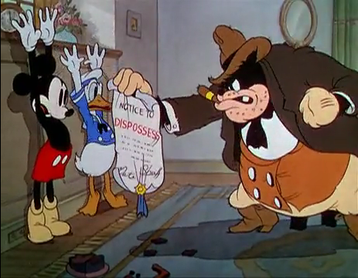A thing I don’t actually mention much in these columns is how much the portrayals of the various characters tie into the era. Bing Crosby Mickey is, let’s face it, a product of the post-war era and is aspirational. The George Geef years for Goofy were in the ’50s and tie into suburbia. Honestly, even the worst years of Donald Duck, Aquatic Sociopath, can be seen as part of societal fear of juvenile delinquency and the need to properly parent and so forth. Though Donald is, of course, much better as an anti-example—if you’re parenting like Donald Duck, you’re doing it wrong.
And so, when the Depression was going strong, Mickey and friends got evicted. (Well, okay, Goofy doesn’t seem to live there and is just helping out.) Sheriff Pete shows up, presents them with the eviction notice for not paying six months’ rent, and declares that he will sell their furniture. Also he engages in some light police brutality. So Mickey and Donald recruit Goofy, who is an ice truck driver, to sneak their furniture out of the house. Generic cartoon slapstick hilarity ensues, including Goofy’s fight with an apparently sentient upright piano and Donald’s fight with a non-sentient yet still malevolent toilet plunger.
Which is, really, another example of the difference between them—Donald is just naturally at war with the broader forces of the universe, and Goofy needs an actual personal antagonist to be anything but easygoing. That’s just how it is. Frankly, if Donald can’t find an antagonist, he’ll make one. Goofy is happy to wander aimlessly through the world, going about his life and just kind of there. Which is not to say that Goofy isn’t harmed by the universe in general as often as not, but he doesn’t take it as personally.
It’s hard for modern audiences to picture Mickey as poor and running from the law, I think, but remember that this is, as Wikipedia hastens to point out, a Depression film. 1936, our Year of the Month, wasn’t by any stretch the worst of the Depression, but the New Deal certainly hadn’t solved everyone’s problems. Eviction was a fact of life for any number of people—frankly, just as it is now—and it was unsurprising that it would be seen as fodder for a cartoon, even if it does seem a bit more Warners of a plot.
It’s also worth noting that Mickey and Donald are not being shamed for their failure to pay rent. We don’t know why they haven’t; they just haven’t. That doesn’t mean Mickey deserves to get punched or Donald deserves to have matches lit on his bill. Walt himself was, shall we say, not exactly a socialist, but the cartoons often espouse some quite liberal ideals—in this case, that Mickey and Donald should be able to keep their furniture if nothing else and that they’re in the right to try to keep their belongings away from the sheriff. No one in this cartoon is demanding a universal minimum income, but it’s also one of the only cartoons I can think of where the villain is a theoretically legitimate authority figure. Even the Sheriff of Nottingham has been put in place by, essentially, a usurper.
Am I talking more about the sociopolitical angle of things than the cartoon itself? Sure; there’s more to the sociopolitical angle of things than to the cartoon itself. The sequence with the piano is weirdly fascinating; Goofy can’t get it on the truck because it doesn’t want to get on the truck—or, perhaps more accurately, because it would rather screw with Goofy than get on the truck. But the whole thing with the plunger is fairly standard cartoon stuff, and I don’t even remember whatever it is that Mickey’s doing. And I literally just watched the cartoon.
Whereas it’s worth noting that the Depression . . . lingers, in pop culture. Steinbeck would write his first novel about it in this same year. Very few people will mention “Moving Day” in the same breath with In Dubious Battle, I grant you, and certainly not with his Depression novels to come such as Of Mice and Men and The Grapes of Wrath, but they do both have, in their way, the same roots. The Depression would make some people Communist and some people wildly anti-Communist; Mickey went from being evicted to being a symbol of upper-middle class conformity. Presumably because that’s how Walt, who was still voicing him in this cartoon, went himself?
Oh, I guess there is one thing about the cartoon itself that’s worth noting—Sheriff Pete. Who was originally a villain for Oswald the Lucky Rabbit that somehow Disney was able to keep using? Anyway, he had until this point been Pegleg Pete. This is his first colour cartoon, and the first one where he doesn’t have a pegleg. (Though he still remains on Wikipedia’s “fictional amputees” list?) He’s also, of course, less recognizably a cat than Goofy is a dog, but I’m okay with that, speaking as a cat person.
We aren’t worried about eviction, but that doesn’t mean I couldn’t use your support for my Patreon or Ko-fi!

